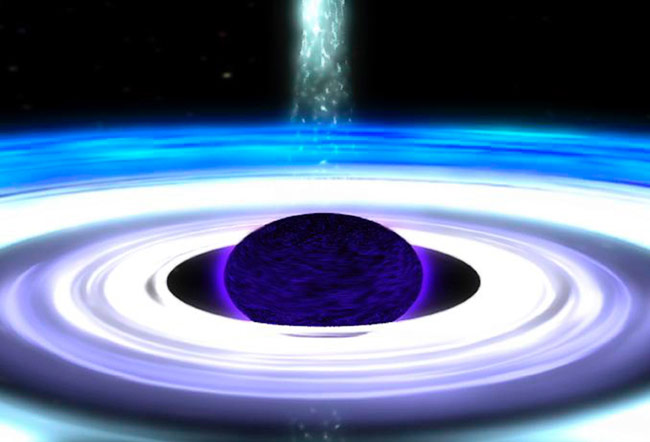Black Hole's Lunch Reveals Its Mass

A group of Cambridge astronomers have detected what appearsto be the rapid spinning of hot gas as it falls into a supermassive blackhole. These first of their kindobservations help pinpoint the mass of the hungry maw that is devouringmaterial from an inward-spiraling disk.
The hefty black hole lies at the center of the galaxy NGC3516, which is about 100 million light years away in the direction of the BigDipper. Material pulled in by thehole's immense gravitational field forms a disk that is heated to hightemperatures, causing it to glow over a broad range of frequencies.
The XMM-Newton satellite observed a sudden brightening ofthe disk in X-rays. Andrew Fabian from Cambridge University and his colleagueshave interpreted this as an X-ray flare occurring close to the black hole. An X-ray flare is somewhat like a solarflare, Fabian said, but its energy is 10 trillion times stronger. The light from the flare excited nearby ironatoms in the accretion disk, causing them to emit a bundle of photons at aspecific frequency.
"It is as if a bit of the disk is being painted," Fabiansaid.
The light from the iron atoms changed over time, implyingthat the "painted" gas was orbiting a very massive object. Calculations involving Einstein's generalrelativity showed that this object, the black hole, weighs between 10 and 50 millionsolar masses.
This result, which will be published in an upcoming issue ofthe Monthly Notices of the Royal Astronomical Society, agrees with otherestimates for the mass of the black hole.
Four Quick Years
The XMM observation lasted about a day, recording fourrevolutions of the excited gas. Theimplied radius is similar to the Earth's distance to the sun, which promptedFabian to imagine what it might be like riding along side the swirling gas. With a "year" lasting only seven hours, anintrepid disk surfer would be traveling at about a tenth of the speed oflight.
Get the Space.com Newsletter
Breaking space news, the latest updates on rocket launches, skywatching events and more!
The sky around Fabian's observer would be overwhelmed by theblack hole, whose width is between 40 and 200 times that of our sun. How exactly all this would look is difficultto fathom, as the immense gravity would bend light in strange ways.
"It would be a spectacular sight," Fabian said.
But the wonderment would be over all too soon. Fabian suspects that the highlighted gasfell into the unforgiving black hole just a few days after the measurements.The exact timing of the demise depends on the viscosity in the disk and whetherthe black hole itself is spinning or not.
Pattern Recognition
Flares are a common occurrence around these supermassiveblack holes. In fact, the tell-taleobservations of NGC 3516 were made three years ago, but it took this recentanalysis to uncover the flare's secret. The lead author, Kazushi Iwasawa, produced a map of the X-ray light thatrevealed a saw tooth pattern in the data.
"The eye is very good at picking out patterns," Fabianremarked.
The researchers perceived a variation in the excited iron'sfrequency, which they attributed to the rotation of the gas as it switchesbetween moving towards us to moving away from us. The frequency shift, called a Doppler shift, is similar to thepitch changes in a "bullroarer" - a traditional instrument that is swung by astring around the player's head.
Besides the Doppler shift, there is also an overall shiftdown in frequency, as photons lose some of their energy climbing out of thegravitational well around the black hole.
Possible Fluke
Although the saw tooth pattern matches theoreticalexpectations for gas spinning around a black hole, it is difficult to makedefinitive statements with only four periods of revolution.
"I think we are lucky. We are at the very limits of detectability," Fabian said.
The researchers ran simulations to confirm that the periodicvariation they were seeing wasn't just a random fluke in the noise. Fabian said that he and his colleagues areoptimistic that the effect is real, but some astronomers have reservations.
"The reactions range from 'Wow' to 'I'm not really sureabout this,'" Fabian said.
Join our Space Forums to keep talking space on the latest missions, night sky and more! And if you have a news tip, correction or comment, let us know at: community@space.com.

Michael Schirber is a freelance writer based in Lyons, France who began writing for Space.com and Live Science in 2004 . He's covered a wide range of topics for Space.com and Live Science, from the origin of life to the physics of NASCAR driving. He also authored a long series of articles about environmental technology. Michael earned a Ph.D. in astrophysics from Ohio State University while studying quasars and the ultraviolet background. Over the years, Michael has also written for Science, Physics World, and New Scientist, most recently as a corresponding editor for Physics.









